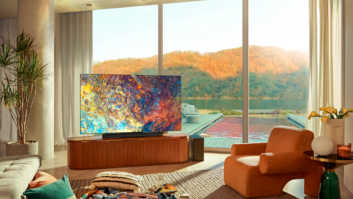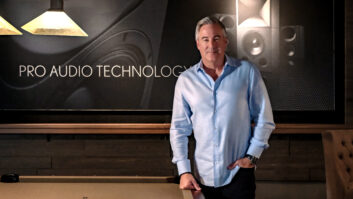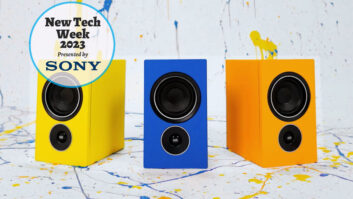What a difference a year makes when it comes to next generation audio formats like Dolby Atmos. Last year every manufacturer demonstrated with the same disc showing the same two or three clips, and who among us didn’t silently beg the universe that we’d never have to sit through Enrique Iglesias’ “Bailando” one more time?
This year Dolby Atmos is well established, there are nearly 20 films already released on Blu-ray, there’s a brand new Dolby demo disc with a huge host of content, and it is being supported by virtually every receiver manufacturer as well as some new Atmos-enabled speaker offerings. We’re also seeing companies adding or announcing support for the other competing 3D audio formats, DTS:X and Auro-3D.
While several manufacturers demonstrated DTS:X material at the show, there have been delays finalizing the decoding, and nearly every product is touting being “DTS:X ready” and will add this feature later as a firmware upgrade. D&M Group says that it expects these updates to start rolling out after the first of the year starting with the flagship Marantz AV8802a and Denon AVR-X7200WA. Denon and Marantz will both support DTS:X in every receiver that does Dolby Atmos, and it will be in all Denon AVR’s $480 and above, and starting in the Marantz line-up at $700. At the show the company ran DTS:X demo clips including a scene from Divergent where the sounds of water bubbled and rose of the sides of the listening room before submerging you overhead. Both Denon and Marantz offer Auro-3D processing as an optional $199 upgrade on their upper-end models.
Both Anthem and Sony launched their first Dolby Atmos receivers, both of which will also be upgradeable to DTS:X. Anthem is coming out with two new receivers, the MRX 720 and the MRX 1120. The 720 features 7 channels of on-board amplification for powering a 5.1.2 system, but features pre-outs for upgrading to a full 7.1.4 system. The flagship 1120 has the same features as the 720 but adds four more amp channels for a full 11-channel system out of the box. Both of these are expected to be available in January.
Beyond a number of features designed specifically for the custom channel, such as an eight-port Ethernet hub with 2 PoE ports, Sony’s new STR-ZA5000ES receiver will sit atop the company’s AVR line-up and feature nine channels of amplification at 130-watts per channel.
At the high-end, Steinway Lyngdorf, JBL Synthesis, and Datasat all displayed processors capable of handling all three audio formats.

JBL demonstrated the company’s latest Synthesis processor and used an over-the-top 13.4.11-channel speaker array, with the additional speaker channels delivering an extra layer of immersion and total hemispherical coverage.
Steinway Lyngdorf showed the finalized version of its P200 processor along with a $161,000 speaker system that handled both 7.2.4 Atmos/DTS:X as well as Auro-3D 11.2, including the “Voice of God” channel. The “Room Perfect” tuned system delivered amazing audio with the Atmos clips from Gravity and Mad Max, as well as the Auro-3D clip from Turbo. The highlight of the demo, however, was a clip from the upcoming Star Wars Battlefront game. While the battle raged on across Hoth, audio swirled and shifted and constantly changed in position to match the on-screen action. Sure, not many can afford a $161,000 (audio only!) gaming rig, but watching this video game was more exciting and had more intense and immersive audio than many of the movies I’ve seen lately.
James Loudspeakers and Wisdom Audio both tapped Datasat for processing for their demos. James utilized Auro-3D for a variety of clips from a system that included 16 speakers, 7 subwoofers, and 25,000 watts of power. Unfortunately none of the clips used were natively encoded in Auro-3D and lacked the impressive immersion quality I’m sure the system was capable of delivering.
Wisdom Audio, on the other hand, demonstrated a 7.4.4 system using the company’s new Line 2 and Point 2 speakers that featured an unexpected gunshot that had such power and volume it literally had me jump in my seat.
While Dolby says you can’t—or rather shouldn’t—install all Atmos speakers in the ceiling, at least two companies at the show questioned this idea. Both Golden Ear Technology and Origin Acoustics demonstrated all in-ceiling Atmos systems to show that this is certainly a viable option in rooms where customers want a clean, speaker-free look.
Golden Ear called its system the “ultimate lifestyle super-stealth,” and used a 5.1.4 system comprised of seven of the company’s Invisa HTR 7000 and two Invisa MPX. Bass chores were handled by the brand new SuperSub XXL. As the demo began, I was aware that the front channel information was positioned higher than the screen; however, after about 10 minutes of watching, my brain and ears stopped being aware of any issues and just reconciled the audio to the screen. The result was terrific localization and soundstaging, without any speakers on the floor. In fact, the rainstorm scene at the end of John Wick played terrifically coming through all ceiling speakers, really drenching you in audio. In a demo scene from Unbroken, Japanese Zero fighter planes streaked past the sides of the room, ripping past your head making you literally snap your head around to follow that action.
Origin Acoustics took the in-ceiling idea even further with a 5.2.4 system that utilized Director 108 speakers and in-ceiling subwoofers. Again, the audio seemed a bit high at first, but I quickly acclimated to it and could just stand and enjoy the sound. Unfortunately Origin was using an older Dolby demo disc with content that was far tamer compared to newer material.
With the popularity of Atmos and soundbars, you knew it wouldn’t be long until an Atmos equipped soundbar hit the market. Well, that day has come in the form of the new Yamaha YSP-5600, which will also support DTS:X. Sadly, Yamaha was not exhibiting at CEDIA, so I was unable to experience the bar.
If you are unable to install new speakers in a customer’s ceiling, there is new news on the Atmos-enabled speaker front. Martin Logan launched the new Motion AFX, a module meant to sit atop Martin Logan speakers, and will be available in approximately 45 days. SpeakerCraft demonstrated the Atmos 100, which appears to be the first in-wall Atmos-enabled module. The cleverly designed module features two 2.5-inch drivers with a 1-inch tweeter in between designed to direct Atmos height information up to the ceiling to be reflected back down towards listeners.







